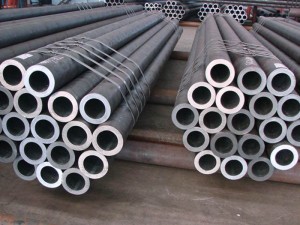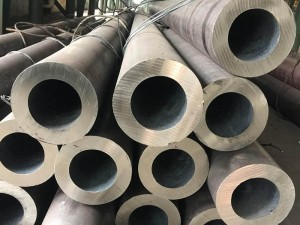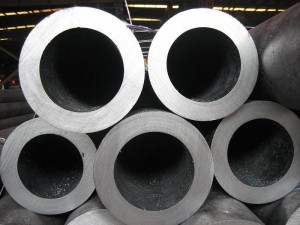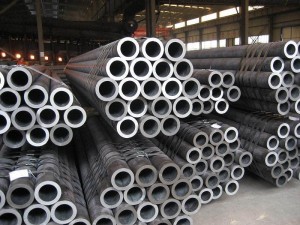-

A106B A53 S45C A333GR.6 thick wall steel pipe quality assurance
The production process of thick-walled seamless steel pipes can be divided into four basic methods: cold drawing, cold rolling, hot rolling, and thermal expansion. Uses are divided into seamless steel pipes for structure; seamless steel pipes for transportation; seamless steel pipes for boilers; high-pressure seamless steel pipes for boilers; high-pressure seamless steel pipes for fertilizer equipment; seamless steel pipes for geological drilling; seamless steel pipes for oil drilling; Seamless steel pipes for petroleum cracking; seamless steel pipes for ships; cold-drawn cold-rolled precision seamless steel pipes; various alloy pipes. Seamless steel pipes are expressed in terms of outer diameter and wall thickness. Thick-walled seamless steel pipes are mainly used for machining, coal mines, hydraulic steel, and many other purposes.
Hot-rolled thick-walled seamless steel pipes, cold-rolled thick-walled seamless steel pipes, cold-drawn thick-walled seamless steel pipes, extruded thick-walled seamless steel pipes, and stainless steel seamless steel pipes for pipe jacking structures (GB/T14975-2002) are used for Seamless steel pipes of general structure and mechanical structure are widely used in the hot-rolled (extruded, expanded) and cold-rolled (extruded, expanded) and cold-rolled stainless steel of corrosion-resistant pipes and structural parts and parts in the chemical, petroleum, textile, medical, food, machinery and other industries. Drawing (rolling) seamless steel tubes.
Stainless steel seamless steel pipes for fluid transportation (GB/T14976-2002) are general seamless steel pipes used to transport water, oil, gas and other fluids. They are usually hot-rolled (extruded, expanded) and cold drawn (rolled) made of stainless steel. ) Seamless steel pipe.
Shaped seamless steel pipe is a general term for seamless steel pipes with cross-sectional shapes other than round pipes. According to the different shape and size of the steel pipe section, it can be divided into equal wall thickness special-shaped seamless steel pipe (code D), unequal wall thickness special-shaped seamless steel pipe (code BD), variable diameter special-shaped seamless steel pipe (code BJ). Special-shaped seamless steel pipes are widely used in various structural parts, tools and mechanical parts. Compared with round pipes, special-shaped pipes generally have larger moments of inertia and section modulus, and have greater bending and torsion resistance, which can greatly reduce structural weight and save steel.
Seamless steel pipe for structure (GB/T8162-2008) is a seamless steel pipe used for general structure and mechanical structure.
Seamless steel pipe for fluid transportation (GB/T8163-2008) is a general seamless steel pipe used to transport water, oil, gas and other fluids.
Seamless steel pipes for low and medium pressure boilers (GB3087-2008) are used to manufacture superheated steam pipes, boiling water pipes for low and medium pressure boilers of various structures and superheated steam pipes for locomotive boilers, large smoke pipes, small smoke pipes and arched brick pipes. High-quality carbon structural steel hot-rolled and cold-drawn (rolled) seamless steel tubes.
Seamless steel pipes for high-pressure boilers (GB5310-2008) are high-quality carbon steel, alloy steel and stainless heat-resistant steel seamless steel pipes for the heating surface of water-tube boilers with high pressure and above.
High-pressure seamless steel pipes for fertilizer equipment (GB6479-2000) are high-quality carbon structural steel and alloy steel seamless steel pipes suitable for chemical equipment and pipelines with a working temperature of -40 to 400 ℃ and a working pressure of 10 to 30 Ma.
Seamless steel pipes for petroleum cracking (GB9948-2006) are seamless steel pipes suitable for furnace tubes, heat exchangers and pipelines in petroleum refineries.
Steel pipes for geological drilling (YB235-70) are steel pipes used for core drilling by geological departments. They can be divided into drill pipes, drill collars, core pipes, casing pipes and sedimentation pipes according to their uses.
Seamless steel pipes for diamond core drilling (GB3423-82) are seamless steel pipes for drill pipes, core rods, and casings used for diamond core drilling.
Petroleum drilling pipe (YB528-65) is a seamless steel pipe that is thickened inside or outside at both ends of oil drilling. Steel pipes are divided into two types: wire and non-wired. Wired pipes are connected by joints, and non-wired pipes are connected with tool joints by butt welding.
Carbon steel seamless steel pipes for ships (GB5213-85) are carbon steel seamless steel pipes used in the manufacture of Class I pressure piping systems, Class II pressure piping systems, boilers and superheaters. The working temperature of the carbon steel seamless steel pipe wall does not exceed 450℃, and the working temperature of the alloy steel seamless steel pipe wall exceeds 450℃.
Seamless steel pipes for automobile axle sleeves (GB3088-82) are high-quality carbon structural steel and alloy structural steel hot-rolled seamless steel pipes used in the manufacture of automobile axle sleeves and axle tubes of drive axle housings.
High-pressure oil pipes for diesel engines (GB3093-86) are cold-drawn seamless steel pipes used to manufacture high-pressure pipes for diesel engine injection systems.
Precision inner diameter seamless steel pipes for hydraulic and pneumatic cylinders (GB8713-88) are cold-drawn or cold-rolled precision seamless steel pipes with precise inner diameters for the manufacture of hydraulic and pneumatic cylinders.
Cold-drawn or cold-rolled precision seamless steel pipe (GB3639-83) is a cold-drawn or cold-rolled precision seamless steel pipe used for mechanical structures and hydraulic equipment with high dimensional accuracy and good surface finish. The use of precision seamless steel pipes to manufacture mechanical structures or hydraulic equipment can greatly save machining man-hours, increase material utilization, and at the same time help improve product quality. -

ASTM A335 P2 P5 P11 P12 P22 alloy steel pipe
P12 alloy tube The alloy tube can be roughly divided into three types: carburized, quenched and tempered and nitrided steel. It has better comprehensive mechanical properties than high-quality carbon structural steel tubes. P12 alloy tubes are mainly used for heating surface tubes of low and medium pressure boilers; heating surface tubes for high pressure boilers, economizers, superheaters, reheaters, petrochemical industry tubes, etc. Alloy pipe is a kind of seamless steel pipe. Alloy pipe is divided into seamless pipe for structure and high pressure heat-resistant alloy pipe. It is mainly different from the production standard of alloy tube and its industry. Annealing and tempering the alloy tube changes its mechanical properties. Achieve the required processing conditions. Its performance is higher than that of ordinary seamless steel pipes. The chemical composition of alloy pipes contains more Cr, and it has high temperature resistance, low temperature resistance and corrosion resistance. Common carbon seamless pipes do not contain alloy components or have few alloy components. The reason why alloy pipes are widely used in petroleum, aerospace, chemical, electric power, boiler, military and other industries is because the mechanical properties of alloy pipes change and adjust. Classification of alloy tubes
(1) Seamless steel pipe
Because of their different manufacturing processes, they are divided into two types: hot-rolled (extruded) seamless steel pipes and cold-drawn (rolled) seamless steel pipes. Cold drawn (rolled) tubes are divided into two types: round tubes and special-shaped tubes.
a. Process overview
Hot-rolled (extruded seamless steel tube): Round tube billet is heated and pierced by three-roll cross-rolling, continuous rolling or extruding, sizing (or reducing), cooling billet straightening water pressure test (or flaw detection) and marking storage.
Cold drawn (rolled) seamless steel pipes: round pipe billets are heated, perforated, headed, annealed, pickled, and oiled (copper-plated). Multi-pass cold drawn (cold rolled) billets are heat treated and straightened.
b. Seamless steel pipes are divided into the following varieties due to their different uses:
GB/T8162-2008 (Seamless steel pipe for structure). Mainly used for general structure and mechanical structure. Its representative materials (brands): carbon steel 20, 45 steel; alloy steel Q345, 20Cr, 40Cr, 20CrMo, 30-35CrMo, 42CrMo, etc.
GB/T8163-2008 (Seamless steel pipe for conveying fluid). Mainly used in engineering and large-scale equipment to transport fluid pipelines. The representative material (brand) is 20, Q345, etc.
GB3087-2008 (Seamless steel tubes for low and medium pressure boilers). Mainly used in industrial boilers and domestic boilers to transport low and medium pressure fluid pipelines. Representative materials are 10 and 20 steel.
GB5310-2008 (Seamless steel tubes for high-pressure boilers). Mainly used for high-temperature and high-pressure conveying fluid headers and pipelines on boilers in power stations and nuclear power plants. Representative materials are 20G, 12Cr1MoVG, 15CrMoG, etc.
GB5312-1999 (Carbon steel and carbon-manganese steel seamless steel pipes for ships). Mainly used for I and II pressure pipes for marine boilers and superheaters. Representative materials are 360, 410, 460 steel grades, etc.
GB6479-2000 (Seamless steel pipes for high-pressure fertilizer equipment). Mainly used for conveying high temperature and high pressure fluid pipelines on fertilizer equipment. Representative materials are 20, 16Mn, 12CrMo, 12Cr2Mo, etc.
GB9948-2006 (Seamless steel pipe for petroleum cracking). Mainly used in boilers, heat exchangers and fluid pipelines of petroleum smelters. Its representative materials are 20, 12CrMo, 1Cr5Mo, 1Cr19Ni11Nb, etc.
GB18248-2000 (Seamless steel tubes for gas cylinders). Mainly used to make various gas and hydraulic cylinders. Its representative materials are 37Mn, 34Mn2V, 35CrMo, etc.
GB/T17396-2007 (Hot-rolled seamless steel pipes for hydraulic props). Mainly used to make coal mine hydraulic supports, cylinders and columns, and other hydraulic cylinders and columns. Its representative materials are 20, 45, 27SiMn and so on.
GB3093-1986 (High-pressure seamless steel pipes for diesel engines). Mainly used for high pressure oil pipe of diesel engine injection system. The steel pipe is generally cold drawn, and its representative material is 20A.
GB/T3639-2007 (cold drawn or cold rolled precision seamless steel tube). It is mainly used for steel pipes used in mechanical structures and carbon pressure equipment that require high dimensional accuracy and good surface finish. Its representative materials are 20, 45 steel, etc.
GB/T3094-1999 (cold drawn seamless steel pipe special-shaped steel pipe). It is mainly used to make various structural parts and parts, and its materials are high-quality carbon structural steel and low-alloy structural steel.
GB/T8713-1988 (Precision inner diameter seamless steel pipe for hydraulic and pneumatic cylinders). It is mainly used to make cold drawn or cold rolled seamless steel pipes with precise inner diameters for hydraulic and pneumatic cylinders. Its representative materials are 20, 45 steel, etc.
GB13296-2007 (Stainless steel seamless steel tubes for boilers and heat exchangers). Mainly used in boilers, superheaters, heat exchangers, condensers, catalytic tubes, etc. of chemical enterprises. Used high-temperature, high-pressure, corrosion-resistant steel pipes. Its representative materials are 0Cr18Ni9, 1Cr18Ni9Ti, 0Cr18Ni12Mo2Ti, etc.
GB/T14975-2002 (Stainless steel seamless steel pipe for structure). It is mainly used for general structure (hotel and restaurant decoration) and mechanical structure of chemical enterprises, which are resistant to atmospheric and acid corrosion and have certain strength steel pipes. Its representative materials are 0-3Cr13, 0Cr18Ni9, 1Cr18Ni9Ti, 0Cr18Ni12Mo2Ti, etc.
GB/T14976-2002 (Stainless steel seamless steel pipe for fluid transportation). Mainly used for pipelines that transport corrosive media. Representative materials are 0Cr13, 0Cr18Ni9, 1Cr18Ni9Ti, 0Cr17Ni12Mo2, 0Cr18Ni12Mo2Ti, etc.
YB/T5035-1993 (Seamless steel pipes for automobile axle casings). It is mainly used to make high-quality carbon structural steel and alloy structural steel hot-rolled seamless steel pipes for automobile half-axle sleeves and drive axle axle tubes. Its representative materials are 45, 45Mn2, 40Cr, 20CrNi3A, etc.
API SPEC5CT-1999 (Casing and Tubing Specification) is compiled and published by the American Petroleum Institute (American Petreleum Instiute, referred to as “API”) and used in all parts of the world. Among them: Casing: the pipe that extends from the ground surface into the well and serves as the lining of the well wall. The pipes are connected by couplings. The main materials are steel grades such as J55, N80, and P110, as well as steel grades such as C90 and T95 that are resistant to hydrogen sulfide corrosion. Its low-grade steel (J55, N80) can be welded steel pipe. Tubing: A pipe inserted into the casing from the ground surface to the oil layer. The pipes are connected by couplings or integrally. The role of the pumping unit is to transport the oil from the oil layer to the ground through the oil pipe. The main materials are steel grades such as J55, N80, P110, and C90, T95 that are resistant to hydrogen sulfide corrosion. Its low-grade steel (J55, N80) can be welded steel pipe.
API SPEC 5L-2000 (line pipe specification), compiled and issued by the American Petroleum Institute, is commonly used all over the world.
Line pipe: The oil, gas or water that is output from the ground is transported to the petroleum and natural gas industrial enterprises through the line pipe. Line pipes include seamless pipes and welded pipes. The pipe ends have flat ends, threaded ends and socket ends; the connection methods are end welding, coupling connection, socket connection, etc. The main material of the tube is B, X42, X56, X65, X70 and other steel grades. -

ASTM A213 T2 T12 T5 T9 T22 P2 P9 alloy steel pipe
Compared with solid steel such as round steel, seamless alloy steel pipe is lighter in flexural and torsional strength and is a kind of economical cross-section steel. Its performance is much higher than that of ordinary seamless steel pipes, because this steel pipe contains more Cr than alloy seamless steel pipes, and its high temperature resistance, low temperature resistance, and corrosion resistance are not comparable to other seamless steel pipes, so alloy pipes It is widely used in petroleum, chemical, electric power, boiler and other industries. T12 alloy pipe has the characteristics of large thermal conductivity, small expansion coefficient, good oxidation resistance, and excellent stress corrosion resistance. It is mostly used in the manufacture of atmospheric, corrosion-resistant, and high-temperature resistant projects. T12 alloy pipe is based on high-quality carbon structural steel pipe by adding one or several alloying elements to improve the mechanical properties, toughness and hardenability of steel. The production of T12 alloy pipe usually requires heat treatment, normalization or quenching and tempering. Before use, it usually needs to undergo quenching and tempering or surface chemical treatment, carburizing, nitriding, surface quenching or high-frequency quenching.
T91 alloy tube belongs to ferritic and austenitic alloy steel seamless steel tubes for boilers, superheaters and heat exchangers (ASTM A213 / A213M-07a)
use:
Used for heating surface pipes of low and medium pressure boilers (working pressure generally not greater than 5.88Mpa, working temperature below 450℃); used for high pressure boilers (working pressure generally above 9.8Mpa, working temperature between 450℃~650℃ ) Heating surface pipes, economizers, superheaters, reheaters, petrochemical industry pipes, etc.
Heat treatment of T91 alloy tube:
The final heat treatment of T91 is normalizing + high temperature tempering. The normalizing temperature is 1040℃, the holding time is not less than 10 min, the tempering temperature is 730~780℃, and the holding time is not less than 1h. The final structure after heat treatment is tempering. Fire martensite -

Thick wall steel pipe manufacturer’s stock
Spot sales of thick wall steel pipe
Thick walled steel pipe, the steel pipe whose ratio of outer diameter to wall thickness is less than 20 is called thick walled steel pipe. It is mainly used as petroleum geological drilling pipe, cracking pipe for petrochemical industry, boiler pipe, bearing pipe, high-precision structural pipe for automobile, tractor and aviation, etc.
-

S45C 1045 XC45 thick wall steel pipe in stock
The key to the quality of thick wall steel pipe is the uniformity of wall thickness. If the wall thickness of thick wall steel pipe is not controlled, it will directly affect the quality and use of steel pipe. Thick wall steel pipe and large-diameter thick wall steel pipe are generally used in various machining and processing of thick wall parts.
-

High temperature and high pressure steel pipe
A333gr6 low temperature pipe is an industrial pipe, which is suitable for seamless steel pipes for low temperature pressure vessel pipes of – 45 ℃ ~ – 195 ℃ and low temperature heat exchanger pipes.
-

A335 P11 A369 FP12 A213T11 alloy steel pipe
T11 alloy tube is called T11 alloy tube because the material is T11. T11 alloy pipe is a product of seamless steel pipe. The solid tube blank is inspected and cleaned of surface defects, cut to the required length, centered on the perforated end surface of the tube blank, and then sent to the heating furnace to be heated and pierced on the punching machine. When the perforation continuously rotates and advances at the same time, under the action of the roller and the plug, a cavity is gradually formed inside the tube blank, which is called a capillary tube. And then sent to the automatic rolling mill to continue rolling. Finally, the whole wall thickness is uniformed by the whole machine, and the diameter is sizing by the sizing machine to meet the specification requirements. It is a more advanced method to produce hot-rolled T11 alloy tubes using continuous tube rolling mills. If the diameter of the production is relatively small, and the precision of the steel pipe and the appearance quality of the surface are relatively high, then the cold drawn process is used for production. T11 alloy tubes are widely used in high-pressure pipelines, vessels, heat exchangers, boiler tubes, and power plants.
The biggest advantage of alloy steel pipe can be 100% recycled, which is in line with the national strategy of environmental protection, energy saving and resource saving. The national policy encourages the expansion of the application field of high pressure alloy pipe. At present, my country’s consumption of alloy pipes accounts for only half of the total steel products in developed countries. The expansion of the use of alloy pipes provides a broader space for the development of the industry. According to the research of the expert group of the Alloy Pipe Branch of the China Special Steel Association, the demand for high-pressure alloy pipe long products in my country will increase by 10-12% annually in the future. Alloy pipe is defined by steel pipe according to the production material (that is, material), as the name suggests, is pipe made of alloy; while seamless pipe is defined by steel pipe according to the production process (seamless and seamless), the difference from seamless pipe is Seam pipes, including straight seam welded pipes and spiral pipes.
The material of alloy tube is roughly as follows:
16-50Mn,
27SiMn,
40Cr,
12-42CrMo,
16Mn,
12Cr1MoV,
T91,
27SiMn,
30CrMo,
15CrMo,
20G,
Cr9Mo,
10CrMo910,
15Mo3,
15CrMoV,
35CrMoV,
45CrMo,
15CrMoG,
12CrMoV,
45Cr,
50Cr,
45CrNiMo and so on.

- Call Support 0086-18365819992
- Email Support sales@weichuanmetal.com






